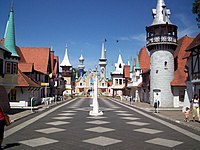
Buenos Aires, officially the Buenos Aires Province, is the largest and most populous Argentine province. It takes its name from the city of Buenos Aires, the capital of the country, which used to be part of the province and the province's capital until it was federalized in 1880. Since then, in spite of bearing the same name, the province does not include Buenos Aires city, though it does include all other parts of the Greater Buenos Aires metropolitan area. The capital of the province is the city of La Plata, founded in 1882.

La Plata is the capital city of Buenos Aires Province, Argentina. According to the 2022 census, the Partido has a population of 772,618 and its metropolitan area, the Greater La Plata, has 938,287 inhabitants. It is located 9 kilometers inland from the southern shore of the Río de la Plata estuary.
Lanús is the capital of Lanús Partido, Buenos Aires Province in Argentina. It lies just south of the capital city Buenos Aires, in the Greater Buenos Aires metropolitan area. The city has a population of 212,152, and the Partido de Lanús has a total population of 453,500.

Quilmes is a city on the coast of the Rio de la Plata, in the province of Buenos Aires, Argentina, on the southeast end of the Greater Buenos Aires, being some 17 km (11 mi) away from the urban centre area of Buenos Aires. The city was founded in 1666 and it is the seat of the eponymous county.

La Plata is a partido in Buenos Aires Province, Argentina, some 60 kilometres (37 mi) southeast of the city of Buenos Aires.

City Bell is a town located in La Plata Partido, Buenos Aires, Argentina. It is located some 10 kilometers from the city center. It forms part of the Greater La Plata urban agglomeration.

The Viceroyalty of the Río de la Plata meaning "River of the Silver", also called "Viceroyalty of the River Plate" in some scholarly writings, in southern South America, was the last to be organized and also the shortest-lived of the Viceroyalties of the Spanish Empire in the Americas. The name "Provincias del Río de la Plata" was formally adopted in 1810 during the Cortes of Cádiz to designate the Viceroyalty of the Río de la Plata.

Palermo is a barrio or neighborhood of Buenos Aires, Argentina. It is located in the north of the city, near the Rio de la Plata.

Núñez is a barrio or neighbourhood of Buenos Aires, Argentina. It is on the northern edge of the city on the banks of the Rio de la Plata. The barrio of Belgrano is to the southeast; Saavedra and Coghlan are to the west; and Vicente López, in Buenos Aires Province, is to the north.

The following is an alphabetical list of topics related to the Argentina.

Merlo is a partido of Buenos Aires Province, Argentina. It is located in Greater Buenos Aires, Argentina, west of the city of Buenos Aires. Its capital is the city of Merlo.

The General Manuel Belgrano Railway (FCGMB), named after the Argentine politician and military leader Manuel Belgrano, is a 1,000 mmmetre gauge railway and the longest of the Argentine system. It was one of the six State-owned Argentine railway companies formed after President Juan Perón's nationalisation of the railway network in 1948.

Wilde is a city in the Avellaneda Partido, Buenos Aires Province, Argentina. Wilde is the most populous district in Avellaneda, with a total of 65,881 inhabitants. It is a part of the Greater Buenos Aires urban agglomeration.

Versalles is a barrio (district) of Buenos Aires, Argentina. It is part of Commune 10 along with Villa Real, Monte Castro, Floresta, Velez Sarsfield and Villa Luro. Versalles is located on the western end of Buenos Aires; its boundaries are marked by the following streets: Nogoyá, Irigoyen, Juan B. Justo Avenue, and the General Paz Expressway.

The Children's Republic, is a theme park located in La Plata, Argentina. With a surface of 53 hectares, and 35 scale buildings, it is regarded as the first theme park in the Americas. The Republic represents a city with all its institutions: parliament, government house, the courthouse, church, port, theater, airport, restaurants, hotels, etc.
Club Universitario de La Plata is an Argentine sports club headquartered in La Plata, Buenos Aires Province. Universitario hosts the practise of a wide range of sports and activities that includes basketball, beach volleyball, bowls, fencing, field hockey, gymnastics, judo, paddle tennis, rugby union, roller skating, rowing, swimming, tejo, tennis, volleyball, water polo and yoga.

Autovía 2 Juan Manuel Fangio is an Argentine dual carriageway, which runs from Buenos Aires to Mar del Plata. The road was a National Route until 1990 when it was transferred to the Government of Buenos Aires Province. The Autovía 2 extends from the junction of Provincial Routes 1 and 36 and National Route A004, just on the traffic circle "Juan María Gutiérrez", which is the limit of Berazategui and Florencio Varela districts.

Provincial Route 11 is a 583-kilometre-long (362 mi) Argentine road in the East of Buenos Aires Province. The road extends from Punta Lara to the town of Mar del Sur.

Tomás Onésimo Canavery (1839–1913) was an Argentine Catholic priest and military chaplain, who served under the command of Bartolomé Mitre during the War of the Triple Alliance. He participated in most of the military actions against the Paraguayan forces, being promoted to lieutenant colonel in the same battlefield by order of General Juan Andrés Gelly y Obes.

The Bristol Hotel was a luxury hotel in Mar del Plata, Argentina. At one time it was patronised by the elite of Buenos Aires. Later it became run down, and in 1944 it was sold, subdivided and rented the premises for commercial use. The hotel building was torn down in 1974. The name survives in the Playa Bristol, the most popular beach in Mar del Plata.




















